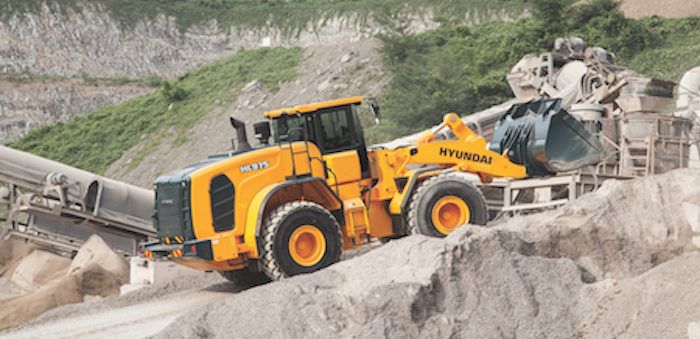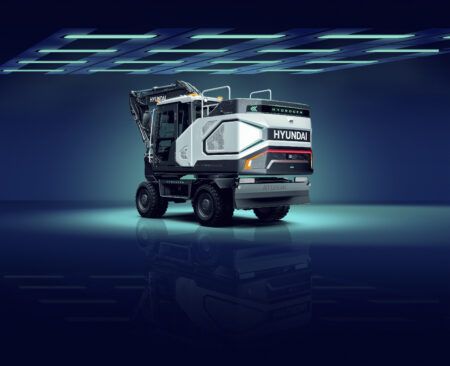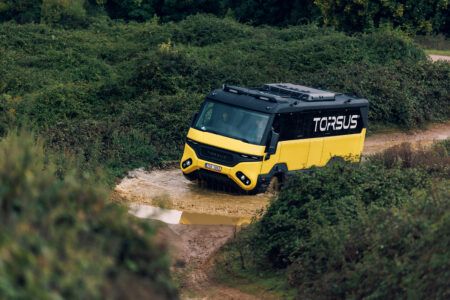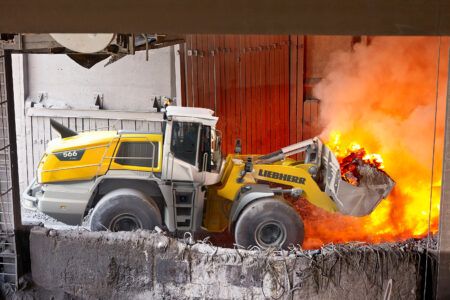Wheel loaders have been the subject of a lot of attention at Hyundai recently. Within the past 12 months, the Korean firm successfully launched the HL900 range of vehicles.
With eight variants available, the HL900 family is already a sizeable one, but Hyundai is not finished and has found space for at least one more. The latest addition is the HL975.
“The new HL975 wheel loader takes an important place in our wheel loader line-up,” says Juston Thompson, product specialist at Hyundai Construction Equipment Americas. “It gives customers a more affordable alternative to larger loaders like the Hyundai HL980, and provides higher horsepower, larger bucket capacity and improved tipping load than the Hyundai HL970 model.”
Bridging the gap between the HL970, with its 7.3 cubic yard bucket, and the HL980, with its 5.75 cubic yard bucket, the company is expecting the new model to be the Goldilocks wheel loader for many customers – not too big, not too small, but just right with its 6.3 cubic yard bucket.Following extensive research among operators across the globe
as to their expectations for the next generation of wheel loaders, the HL975 has been developed to include a number of features and technologies that set it apart even from some other members of the HL900 family.
Even the bucket itself incorporates the latest engineering know-how, with curved side plates preventing material spilling. Made out of high-grade anti-wear steel, the bucket also has an enhanced spill guard at the back that protects the wheel loader’s joints from potential damage.
New power generation
It is in the powertrain, though, where the HL975 distinguishes itself from other wheel loaders in the Hyundai range.
All of the vehicles in the HL900 series have Tier 4 Final-compliant engines, but while its closest relatives (the HL970 and HL980) are powered by Scania engines, underneath the hood of the HL975 there is a Cummins QSG12 unit instead.
The decision to introduce a different engine was an intentional one and was not taken lightly, explains Thompson.
“We had some requests from customers who said they would like a Cummins engine,” he says. “They had previously shown a lot of loyalty to the Cummins engine,
and here in North America they were very familiar with it as it is used in the majority of our products, so they wanted a machine with the Cummins engine.”
Providing maximum gross power of 250kW at 2,100rpm and gross torque peaking at 1,765Nm, the engine gives the vehicle considerable power to handle the inevitably tough tasks of digging and loading in quarries, gravel pits and surface coal mine environments.
Running cleaner
Boasting such performance figures is all well and good, but the modern wheel loader is also expected to meet increasingly stringent emissions legislation.
Along with selective catalytic reduction technology and a diesel particulate filter, there is a suite
of engine technologies to ensure that the HL975 satisfies the fuel efficiency requirements placed
on it as well.
Equipped with an eco-pedal, the operator is able to maximize fuel savings when using anything between 0% and 85% of the engine throttle. When circumstances require more, additional pressure on the pedal provides the necessary extra power to make sure the job gets done. An automatic shut-down functionality on the engine enables the operator to adjust the settings for how long it runs in an idle state before the system stops – reducing unnecessary fuel consumption and emissions in the process.Additionally, load-sensing hydraulics provide precise control of piston pumps and discharge the minimum oil pressure and flow required to enhance engine efficiency further, while a hydraulic lock differential prevents tires slipping during operation to also limit fuel losses and improve productivity.
Worth its weight
The HL975’s technologies, however, extend much further than the engine.
“There is an integrated auto-weigh system that allows the operator to track individual materials,” says Thompson. “It increases productivity by making sure materials are weighed out properly. It weighs the amount collected in the bucket before it is dumped and can then also show the cumulative total dumped, so it can show the total number of loads put into the truck and has the ability to track three different materials.
“At the end of the day, it’ll all be put through the Hi-Mate system, which is our telematics tool, and you can then go online and see what was the exact output by that machine.”
Of all the vehicle’s features, it is the auto-weigh system that Thompson believes sets the HL975 apart from its wheel loader competitors.
Accurate to ±1%, the system is considerably more accurate than typical onboard scales. The measurement results produced, as well as various other informative facts and figures, are displayed on a new 7in color touchscreen monitor.
Thompson concludes, “The HL975 wheel loader provides features that combine to give our customers what we call ‘the Hyundai edge’ – performance, convenience, serviceability and safety.”
When the technologies and features are all combined, with the HL975, Hyundai seems to have covered all bases for the needs of today’s wheel loader operators.





